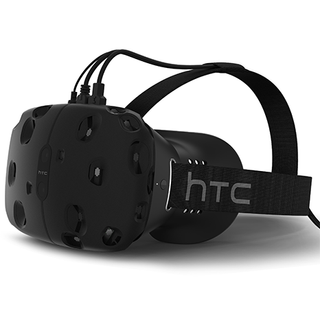Oculus Rift Vs. HTC Vive Vs. PlayStation VR
The Oculus Rift and HTC's Vive are now available and later this year, Sony's Playstation VR is coming out. This guide offers a comparison between the three and will help you device which VR system is right for you.
HMD Design, Ergonomics And Comfort
In this section, we are just going to compare the actual headsets, not the tracking hardware and controls, which will be covered in the following section.
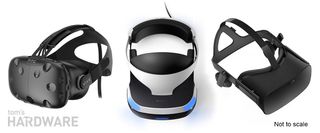
The three headsets all look quite different, and you can tell that HTC, Oculus, and Sony have slightly different philosophies about what makes a great VR HMD. When it comes down to it, there are five key areas within which we can compare the headsets: design, comfort, adjustability, visuals and audio. For visuals, we’ll be talking about the overall visual experience of each headset, since we covered the technical details in the previous section.
Engineering And Design
The HTC Vive's design most resembles the black ski goggles aesthetic that many people associate with VR headsets, other than the recessed sensors dotted all over its black plastic structure. It certainly looks the most complex of the three. The consumer Vive isn’t that much different than the Vive Pre, the second-gen developer kit, with only a few differences in the head strap design to differentiate the two.

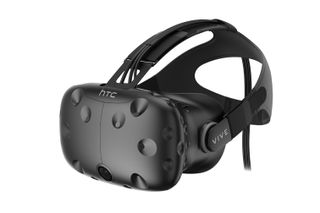
Compared to the original developer kit, both the Pre and consumer Vive are much more polished products, but no matter how you slice it, the Vive is an intimidating piece of VR kit.
The Oculus Rift consumer version (CV1) is significantly different than the last developer headset the company sold (DK2). There were almost two years between the DK2’s release and the CV1’s, which allowed Oculus to really refine the HMD design. When we attended Oculus Connect 2 (its annual developer conference) last fall we saw a presentation about the design of the Rift, and we learned from it that Oculus was fairly obsessed with getting the Rift’s design right.
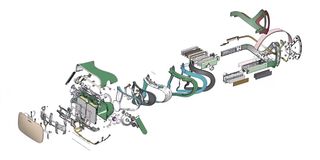
The CV1 is made up of hundreds of parts, many of them customized rather than being off-the-shelf components, and the goal is, in fact, to make the VR hardware disappear when worn, so the user can fully appreciate the VR experience. With that in mind, unlike the hard plastic of the Vive and PSVR, the Rift is covered in fabric; yes, a custom stretchable material that doesn’t block the HMD’s IR tracking sensors. This design choice wasn’t just for weight savings. The fabric is also permeable, allowing the Rift to breathe, and because this fabric is also being used around the lenses it helps keep your face cool when pressed into the headset, assisting with comfort and preventing the lenses from fogging up.
You can tell at a glance that Sony took a very different approach when designing the PlayStation VR headset. To start, it certainly looks very “Sony,” with its sleek lines, black and white plastic, and glowing blue tracking LEDs. It’s almost like it came straight out of an anime compared to the cyberpunk aesthetic of the Vive and California minimalism of the Rift.
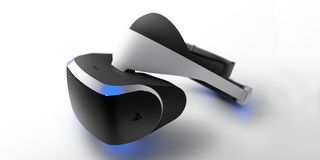
It’s also interesting that unlike the Vive and Rift, PlayStation VR has always looked like a finished consumer-ready product, even as far back as when Sony unveiled the prototype in 2014 (then called Project Morpheus). Clearly Sony’s many decades of design and manufacturing experience played a big part in this, and we get the feeling that the PSVR’s actual hardware has been practically finished for a while now. Sony is only releasing it in the fall because the company is waiting for a compelling VR software library to be ready for the launch.
Despite some of the differences, all three headsets are exceptionally well made. As far as build quality goes, none of them has an advantage, and at these retail prices one would hope for a premium product in every aspect.
Ergonomics, Comfort And Cable Management
The Vive sits in the middle when it comes to size and weight (563g), while the Rift is the smallest and lightest (470g) of the three, and PlayStation VR sits at the opposite end of this spectrum (610g). When it comes to ergonomics and comfort, though, size and weight aren’t the only factors that determine how a headset fares because out of the three, the Vive is the least comfortable. Which is not to say it’s uncomfortable, because we’ve used the Vive for extended periods without any issues. It’s just that the other HMDs have even better ergonomics.
The design of the Vive's head straps, the materials used, its balance, and its cable management aren’t as refined as the other headsets. Its three-point harness is made from fabric and has Velcro adjustments, and it takes a bit of time to get the straps set just right for your head.

It’s important to ensure the straps are seated properly with the back's oval section cupping the back of your head as low on your skull as possible to help properly distribute the Vive’s (front biased) weight, rather than it all pressing into your face. When everything is adjusted right, the Vive is comfortable to wear for long periods, it just takes more effort to get there. One nice bonus of the head strap design, though, is that it easily accommodates long hair. Although the Rift’s straps are similarly shaped at the back, they contain tracking sensors, so you need to pull your hair to the side when wearing it.
The Vive also has two other ergonomic issues. First, it suffers from a lack of adequate ventilation. That, combined with the fact that out of the three HMDs it has the tightest seal on your face (and that room-scale VR experiences are inherently more strenuous), means that your face gets pretty hot when using the Vive. Depending on how much you perspire, this can be an issue, with the thick foam face cushion getting drenched in sweat, which is not ideal when sharing the Vive with someone. Also, the heat build-up can potentially lead to lens fogging, depending on the temperature of your surroundings.
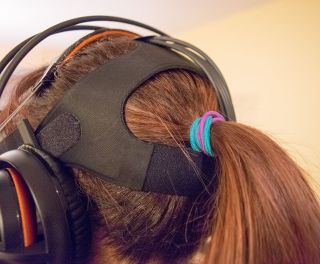

The other issue is the Vive's cable. The Rift combines both HDMI and USB into a single reasonably thin cable, but the Vive has three cables (HDMI, USB, and power) joined into a wide (2 cm) snake that runs from the headset over your head and down your back. Although with use (and this applies to all three systems) you gain what we would call “cable-sense,” subconsciously becoming aware of the cable so you don’t trip over it. Still, the Vive’s is the most obtrusive and the hardest cabling to ignore.
Even though on paper the Rift is only 93g lighter than the Vive, that amount of weight can make all the difference over extended periods. It’s not just its mass,though, it’s also the overall ergonomic design of the Rift that simply makes it more comfortable than the Vive. As we mentioned, Oculus put a lot of effort into perfecting the design of the Rift CV1, and its ergonomics are where it shows the most.

To start, its weight is more evenly balanced than the Vive’s, so much so that it feels a lot lighter than it is. Like the Vive, the initial Velcro adjustments needed for all three straps can take some time to get right, but once its dialed in it’s a lot easier to use. That’s because the front of its thicker, more rigid side straps are spring-loaded where they join to the face mask, allowing you to easily pull the headset away from you face when putting it on or taking it off without having to adjust anything.
The reason for the thicker side straps is that they have to also contain the connectors for the integrated headphones and support the tracking sensors in the triangular back of the head straps, but there’s an ergonomic benefit too. With it correctly adjusted and the rigid rear triangle positioned low on the back of your skull, the Rift is perfectly balanced, and you can feel almost no pressure on your face. That’s a good thing too because the thin foam of the facial interface is pretty dense and doesn’t offer much in the way of padding.
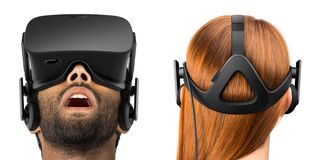
It also does a good job of conforming to the contours of your face to prevent light leakage, apart from around your nose. Yes, the Rift does have a noticeable gap surrounding your nose, and it's there for both comfort and ventilation purposes, but there is some light that shines through and it can impact immersion when using the Rift in brighter environments. But this is probably a fair compromise to accommodate comfortably different nose sizes, especially for those of us with bigger snouts. The ventilation from the nose gap and the fabric used throughout the Rift’s construction, along with the the sedentary experiences of current games, means that your face doesn’t get nearly as hot when using the Rift.
Unlike the Vive’s thick serpent of a cable, the Rift uses a single thin proprietary cord which combines both the USB and HDMI signals into one. Instead of running it down the middle of your head like the Vive, it runs along the left side of the Rift behind your ear so as not to block the tracking sensors on the back of the head straps. Because of its size, it is significantly less noticeable that the Vive’s cable, and although it's not obvious, it can be unplugged from the headset. But it uses a proprietary connector on the HMD end.
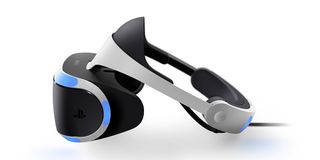
The PlayStation VR is the heaviest of the three headsets. What may initially seem strange then is that it is also the most comfortable. Sony’s headset design is simply ergonomically better than the Vive and Rift. Unlike Oculus and HTC, whose headsets are both first attempts at consumer VR hardware (we’re not counting the developer kits), Sony has had many years of experience designing a selling head mounted displays to consumers with its Personal Viewers, the HMZ-T1, T2, and T3. We’re not surprised, then, at how good the PSVR feels.
Unlike the ski goggles design approach that both Oculus and HTC built upon, PSVR is ergonomically closer to a welder’s mask, with a very heavily padded band that circles your head like a crown. The band is angled, so its large frontal area rests on your forehead and the face mask hangs from the band, with its weight distributed across your forehead rather than pressing into your face, with a counterbalance weight in the back of the ring to further improve the headset’s balance.
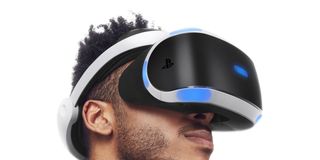
Because of this design, the PSVR’s display and optics just touch your face; instead of the foam of the Vive and Rift, Sony’s headset has a rubbery plastic surround with flaps on the side to help seal off light. However, when compared to the other headsets, there is more light leakage, because of the large gap around your nose (much larger than the Rift’s) and because of the design of the side flaps. While you can adjust the distance of the face mask by sliding it back and forth (after pressing a button on the bottom), even when set as close as possible, PlayStation VR is a tad less immersive than the other headsets in bright environments.
Still, the lack of a tight seal on your face means that there is more ventilation, so there shouldn’t be any issues with heat build-up when using it. Sony also designed the HMD for ease of use. Instead of having to fiddle with three straps like with the Vive and Rift, PSVR has a single dial to tighten the ring onto your head. Then to remove it, you simply press the quick-release button on the rear of the ring to take it off in seconds. This is going to help immensely when sharing it with friends because adjusting it for someone else’s head will take seconds rather than minutes.
Optical Adjustments And Glasses Compatibility
Adjustability also determines HMD comfort. There are three settings that are important for the optimal VR experience: focus, interpupillary distance (IPD), and lens-to-eye distance. The last one is especially important for people who wear glasses because there needs to be enough room between yours eyes and the lenses to accommodate them.
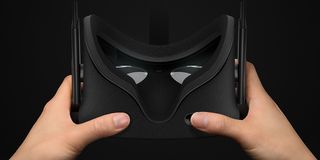
None of the three HMDs has focus control because their optics are focused at infinity, so there is no need to adjust it. Despite that, there is a sweet spot on the lenses of all three where the image is the clearest. The Vive does have the smallest sweet spot, and it's not that the image is only in focus in this area, but that it is less forgiving when it comes to positioning the lenses in front of your eyes. To get the clearest image the headset needs to be adjusted properly; your eyes need to be as close to the lenses as possible, and the IPD has to be right. The Rift’s hybrid lenses are less finicky, and their sweet spot is bigger, with Oculus suggesting that for the clearest image you simply just need to move the headset up and down on your head to find the position that’s right for you. PlayStation VR also has a wider area to focus on, which is a good thing because it’s the least optically adjustable of the three HMDs.
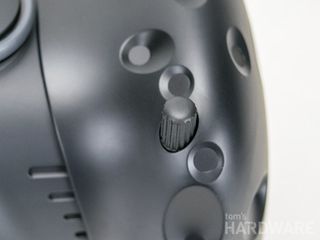

Both the Vive and Rift have proper IPD adjustment, the Vive with a dial on the side and the Rift with a slider on the bottom of the HMD. IPD is a crucial adjustment, not just for helping align the sweet spot with your eyes, but also to reduce eye strain. The distance is the space between your eyes, and if you’re going to be staring into a display inches from your face for hours you want to be sure your eyes are as comfortable as possible.
The range of adjustment on both the Vive and Rift is similar (~14 mm) and covers most adult faces (which have an average IPD of 64 mm), with the Rift having the lowest starting IPD of 58 mm. Unfortunately, even the lowest setting of the Rift’s IPD isn’t narrow enough for young children, which likely is one of the reasons why the Rift has an age rating of 13+. There are also some adults with very low IPDs too.
To set the IPD on the Vive you just turn the dial while wearing the headset, and a small on-screen pop-up appears, telling you the distance. There is no calibration tool, though, so you have to know your IPD beforehand (you can use this guide by Oliver Kreylos to measure it). The Rift has a proper IPD calibration software routine when you first set up the HMD, and if you decide to adjust the IPD later, it comes up again. Sony does not have any physical IPD adjustment; you adjust it in software, but we’re not sure if that means it moves the lenses, or something else is adjusted to achieve the right setting.


Being able to adjust the lens-to-eye distance allows you to maximize the perceived FoV when the lenses are close to your eyes, and move them back if you need room for glasses. With the Vive, the optimal distance is 8 mm, and it is very easy to adjust the eye-relief with the two dials on the side of the headset where the head straps attach to the face mask. The Rift does not have any way to adjust the lens to eye distance. The foam facial interface is removable, however, and when Oculus announced the consumer version of the Rift, it said that a spacer and two different sized interfaces would be included in the box, both to adjust eye relief and to accommodate glasses. Now it looks like these will be sold separately.
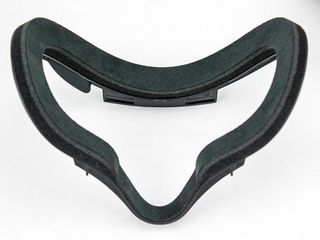
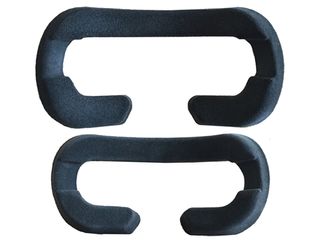
Along with the adjustable lens-to-eye distance, the Vive also has a removable foam face cushion like the Rift, and there are two sizes included in the box. The different options are to accommodate different facial structures and for different sized glasses. You’ll also notice that there is a cut out in the foam for the frame of your glasses too. This means that the Vive is easily the best of the three headsets for people who wear glasses. The Rift is the least glasses friendly, although Oculus says you can fit glasses with frames less than 142 mm wide and 50 mm high; there is still the problem of the fit being very tight. In fact, you’ll often find that your glasses get stuck to the Rift’s facial interface, so when you remove the headset it either gets pulled off and stays attached to your face with the glasses, or your glasses get pulled off with the HMD instead.

PlayStation VR is also very adjustable when it comes to eye relief and glasses. You can push a button on the bottom of the face mask to easily adjust its distance from your face. The design of the rubber flaps and surround is very accommodating for all facial structures, and there is plenty of room for glasses without needing to replace anything.
Current page: HMD Design, Ergonomics And Comfort
Prev Page HMD Specifications, Displays, Lenses And FoV Next Page Audio Visual Experience And Other FeaturesStay on the Cutting Edge
Join the experts who read Tom's Hardware for the inside track on enthusiast PC tech news — and have for over 25 years. We'll send breaking news and in-depth reviews of CPUs, GPUs, AI, maker hardware and more straight to your inbox.
-
nitrium Apparently the PSVR has already been hacked to work on PCs (and Sony is considering official PC support after launch) - I wonder if it might be the best headset to get IF you have a PC, given that from this article at least the number one issue with PSVR is the PS4 it's being attached to.Reply -
problematiq I feel the PSVR got a bit over hyped in this article, in all fairness though it's not released yet so not a lot to go on. As an owner of the HTC Vive I can say "Yes your face will get warm/sweaty if you are in a warm room". I keep a fan blowing tword the center of the room to fix that problem, plus it makes me feel like I'm feeling the wind in VR. o.o All in all was the best purchase I've made in sometime. My wife who does not really like to play games enjoys it A LOT. It is also just a really hard experience to describe other than "Awesome". I don't know how I would feel without the full room scale and motion controllers, I think it would feel novel like playing games in 3D, sure it's cool but not practical and after a while your glasses sit there gathering dust. The ability to reach over and more or less grab and object, play around with it and even toss it, I'm just not sure how I could take off the HMD and put on the Rift and have an experience as good as that of the Vive. All of the HMD's are heading twords the same goal in the end though and it's evident.Reply -
Jeff Fx >and they don't have low refresh rate displaysReply
I think you wrote "low" when you meant "high." -
Zapin So comparing one currently non-existant HMD to two others (one of which is still an incomplete experience) that run on a totally separate platform? Makes sense to me.Reply -
picture_perfect Wait for Polaris / Pascal cards later this month which will be 2X faster in VR apps. Well that is the Nvidia claim. Other VR specifics mentioned like (ray trace audio, specialized projection ect.). These are the first "VR cards".Reply -
Sven Viking The C:-drive-only issue was fixed a while ago, by the way, though (for now at least) you still need to choose one drive and stick to it rather than being able to split games between drives.Reply
For international pricing, don't forget to take high shipping costs and (for Vive to AU/NZ at least) customs fees into account. -
problematiq Reply17976471 said:Wait for Polaris / Pascal cards later this month which will be 2X faster in VR apps. Well that is the Nvidia claim. Other VR specifics mentioned like (ray trace audio, specialized projection ect.). These are the first "VR cards".
I run a 980 TI with the Vive and my load barely see's 30% I'm not sure what you are gaining for waiting on a "VR Card" -
Deric_ How can PSVR do roomscale with only a single camera?Reply
Your controllers will get occluded everytime your body is between them and the camera.
If you have to face a single direction to play, then it is not room scale. -
alex davies ReplyApparently the PSVR has already been hacked to work on PCs (and Sony is considering official PC support after launch) - I wonder if it might be the best headset to get IF you have a PC, given that from this article at least the number one issue with PSVR is the PS4 it's being attached to.
A PC-compatible PSVR would only be the best VR headset from a price perspective. Yes, having a PC power it would improve the fidelity of the in-game graphics, but despite being the most ergonomic, it's still a step below both the Rift and Vive technically. Well, Rift + Touch, because as the moment the lack of tracked controllers handicaps the Rift. -
alex davies Reply>and they don't have low refresh rate displays
I think you wrote "low" when you meant "high."
Fixed, thanks!
